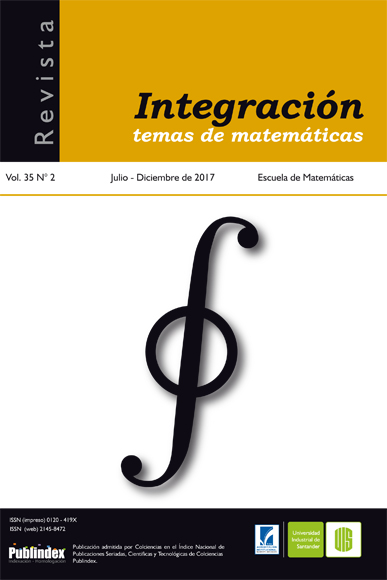Artículos científicos
Publicado 2018-03-06
Palabras clave
- Conexidad,
- conexidad en pequeño,
- conexidad local,
- progresión aritmética,
- topología de Golomb.
Cómo citar
Alberto-Domínguez, J. del C., Acosta, G., Delgadillo-Piñón, G., & Madriz-Mendoza, M. (2018). El espacio de Golomb y su no conexidad en pequeño. Revista Integración, Temas De matemáticas, 35(2), 189–213. https://doi.org/10.18273/revint.v35n2-2017004
Resumen
En el presente trabajo, estudiamos los espacios de Brown, que son conexos y no completamente de Hausdorff. Utilizando progresiones aritméticas, construimos una base BG para una topología τG de N, y mostramos que (N, τG), llamado el espacio de Golomb, es de Brown. También probamos que hay elementos de BG que son de Brown, mientras que otros están totalmente separados. Escribimos algunas consecuencias de este resultado. Por ejemplo, (N, τG) no es conexo en pequeño en ninguno de sus puntos. Esto generaliza un resultado probado por Kirch en 1969. También damos una prueba más simple de un resultado presentado por Szczuka en 2010.
Descargas
Referencias
[1] Apostol T.M., Introduction to Analytic Number Theory, Springer Verlag, New York-Heidelberg, 1976.
[2] Brown M., "A countable connected Hausdorff space", in The April Meeting in New York, Bull. Amer. Math. Soc. 59 (1953), No. 4, 367.
[3] Clark P.L., Lebowitz-Lockard N. and Pollack P., "A note on Golomb topologies", Preprint.
[4] Engelking R., General Topology, Revised and Completed Edition, Sigma Series in Pure Mathematics Vol.6. Heldermann Verlag, Berlin, 1989.
[5] Fine B. and Rosenberger G., Number Theory. An Introduction via the Density of Primes, Second Edition, Birkhäuser, 2016.
[6] Furstenberg H., "On the infnitude of primes", Amer. Math. Monthly 62 (1955), No. 5, 353.
[7] Golomb S.W., "A connected topology for the integers", Amer. Math. Monthly 66 (1959), No 8, 663-665.
[8] Golomb S.W., "Arithmetica topologica", General Topology and its Relations to Modern Analysis and Algebra, Proceedings of the Symposium held in Prague in September 1961. Academia Publishing House of the Czechoslovak Academy of Sciences, Prague, 1962, 179-186.
[9] Kirch A.M., "A countable, connected, locally connected Hausdorff space", Amer. Math. Monthly 76 (1969), No. 2, 169-171.
[10] Margalef Roig J., Outerelo Domínguez E. and Pinilla Ferrando J.L., Topología, Editorial Alhambra, Madrid, 1979.
[11] Niven I., Zuckerman H.S. and Montgomery H.L., An Introduction to the Theory of Numbers, Fifth Edition, John Wiley and Sons, Inc., New York, Chichester, Brisbane, Toronto, Singapore, 1991.
[12] Steen L.A. and Seebach Jr. J.A., Counterexamples in Topology, Reprint of the Second (1978) Edition Original Springer-Verlag, New York. Dover Publications, Inc., Mineola, New York, 1995.
[13] Szczuka P., "The connnectedness of arithmetic progressions in Furstenberg's, Golomb's and Kirch's topologies", Demonstratio Math. 43 (2010), No. 4, 899-909.
[14] Szczuka P., "Connections between connected topological spaces on the set of positive integers", Cent. Eur. J. Math. 11 (2013), No. 5, 876-881.
[15] Szczuka P., "Regular open arithmetic progressions in connected topological spaces on the set of positive integers", Glas. Mat. Ser. III 49(69)(2014), No. 1, 13-23.
[16] Szczuka P., "The closures of arithmetic progressions in the common division topology on the set of positive integers", Cent, Eur. J. Math. 12 (2014), No. 7, 1008-1014.
[17] Szczuka P., "The closures of arithmetic progressions in Kirch's topology on the set of positive
integers", Int. J. Number Theory 11 (2015), No. 3, 673-682.
[18] Szczuka P., "Properties of the division topology on the set of positive integers", Int. J. Number Theory 12 (2016), No. 3, 775-785.
[19] Willard S., General Topology, Reprint of the 1970 Original Addison-Wesley, Rending, MA. Dover Publications, Inc., Mineola, New York, 2004.
[2] Brown M., "A countable connected Hausdorff space", in The April Meeting in New York, Bull. Amer. Math. Soc. 59 (1953), No. 4, 367.
[3] Clark P.L., Lebowitz-Lockard N. and Pollack P., "A note on Golomb topologies", Preprint.
[4] Engelking R., General Topology, Revised and Completed Edition, Sigma Series in Pure Mathematics Vol.6. Heldermann Verlag, Berlin, 1989.
[5] Fine B. and Rosenberger G., Number Theory. An Introduction via the Density of Primes, Second Edition, Birkhäuser, 2016.
[6] Furstenberg H., "On the infnitude of primes", Amer. Math. Monthly 62 (1955), No. 5, 353.
[7] Golomb S.W., "A connected topology for the integers", Amer. Math. Monthly 66 (1959), No 8, 663-665.
[8] Golomb S.W., "Arithmetica topologica", General Topology and its Relations to Modern Analysis and Algebra, Proceedings of the Symposium held in Prague in September 1961. Academia Publishing House of the Czechoslovak Academy of Sciences, Prague, 1962, 179-186.
[9] Kirch A.M., "A countable, connected, locally connected Hausdorff space", Amer. Math. Monthly 76 (1969), No. 2, 169-171.
[10] Margalef Roig J., Outerelo Domínguez E. and Pinilla Ferrando J.L., Topología, Editorial Alhambra, Madrid, 1979.
[11] Niven I., Zuckerman H.S. and Montgomery H.L., An Introduction to the Theory of Numbers, Fifth Edition, John Wiley and Sons, Inc., New York, Chichester, Brisbane, Toronto, Singapore, 1991.
[12] Steen L.A. and Seebach Jr. J.A., Counterexamples in Topology, Reprint of the Second (1978) Edition Original Springer-Verlag, New York. Dover Publications, Inc., Mineola, New York, 1995.
[13] Szczuka P., "The connnectedness of arithmetic progressions in Furstenberg's, Golomb's and Kirch's topologies", Demonstratio Math. 43 (2010), No. 4, 899-909.
[14] Szczuka P., "Connections between connected topological spaces on the set of positive integers", Cent. Eur. J. Math. 11 (2013), No. 5, 876-881.
[15] Szczuka P., "Regular open arithmetic progressions in connected topological spaces on the set of positive integers", Glas. Mat. Ser. III 49(69)(2014), No. 1, 13-23.
[16] Szczuka P., "The closures of arithmetic progressions in the common division topology on the set of positive integers", Cent, Eur. J. Math. 12 (2014), No. 7, 1008-1014.
[17] Szczuka P., "The closures of arithmetic progressions in Kirch's topology on the set of positive
integers", Int. J. Number Theory 11 (2015), No. 3, 673-682.
[18] Szczuka P., "Properties of the division topology on the set of positive integers", Int. J. Number Theory 12 (2016), No. 3, 775-785.
[19] Willard S., General Topology, Reprint of the 1970 Original Addison-Wesley, Rending, MA. Dover Publications, Inc., Mineola, New York, 2004.
